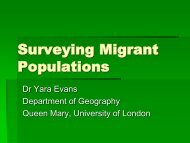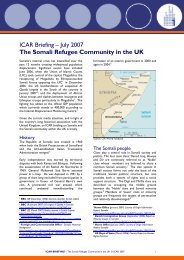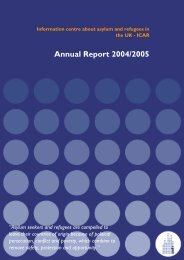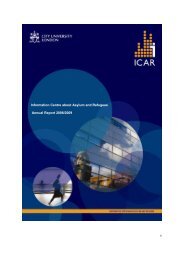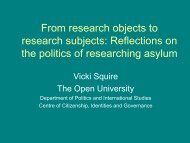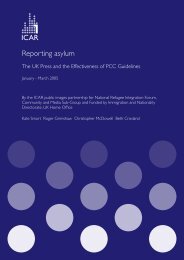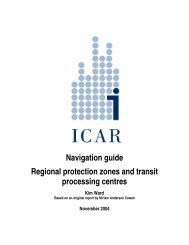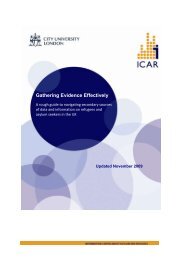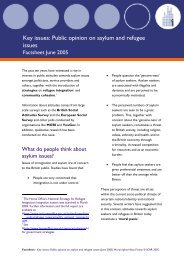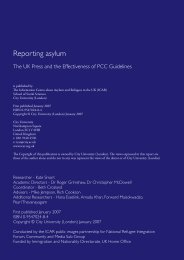Uncovered: assessing media and communications needs ... - ICAR
Uncovered: assessing media and communications needs ... - ICAR
Uncovered: assessing media and communications needs ... - ICAR
- No tags were found...
Create successful ePaper yourself
Turn your PDF publications into a flip-book with our unique Google optimized e-Paper software.
A further recent report for the Changing Perspectives campaign tackles <strong>media</strong> coverage of Africanpeople living with HIV 11 . It says that although African people account for the majority of newdiagnoses in Britain they are failing to come forward for testing or health care because of stigma <strong>and</strong>discrimination. It calls on African communities <strong>and</strong> others to publicly speak out to help reduce thatstigma.The Department for Communities <strong>and</strong> Local Government recently produced a ‘what works’ guidefor agencies working with refugees, asylum seekers <strong>and</strong> migrant worker in neighbourhood renewalareas 12 . The guide describes these groups as being isolated <strong>and</strong> marginalised from community life<strong>and</strong> highlights the role of the <strong>media</strong> in raising awareness. Some of the case studies mentioned in thereport have recognised the need for <strong>communications</strong> training <strong>and</strong> one, based in East Manchester hasalready run workshops on the subject.Elsewhere, a report by the Commission on Integration <strong>and</strong> Cohesion talks of the need for what it callsa ‘whole community’ approach – including all those who live at the margins, <strong>and</strong> not simply thosefalling into BME, refugee or other categories. 13 It highlights the effectiveness of campaigns such asthose by faith groups that have utilised the <strong>media</strong> to convey inter-faith partnerships <strong>and</strong> interaction athigh profi le, tense periods.A number of infrastructure organisations are trying to raise awareness of the role of <strong>media</strong> <strong>and</strong><strong>communications</strong>. Refugee integration fora in London <strong>and</strong> the regions, for example, have runworkshops <strong>and</strong> training sessions on the subject <strong>and</strong> some are running dedicated schemes to increase<strong>media</strong> coverage of asylum <strong>and</strong> refugees.In rural areas geographical remoteness may be the most crucial barrier to participation. TheCommission for Rural Communities has sought to identify new approaches to, amongst other things,giving voice to people at the margins of society. 14 It uncovered a range of factors affecting successfulengagement. Another CRC report on migrant workers found that their ‘issues, <strong>needs</strong> <strong>and</strong> concernsare seldom articulated <strong>and</strong> represented by migrant workers themselves, rather than by others on theirbehalf’. 15Previous research into the <strong>media</strong> <strong>and</strong> the aforementioned groups has focused on the impact, <strong>and</strong>sometimes potential, of coverage in the print <strong>media</strong>. The growth of the internet as a <strong>communications</strong>tool has brought with it new promise of breaking down economic <strong>and</strong> geographical barriers. Howeverresearch by Plymouth University found that IT <strong>needs</strong> amongst marginalised communities were notfully investigated prior to the development of services supposed to benefi t them – lack of participationin defi ning the problem by prospective users meant that ‘social exclusion became embedded in thevery attempt to challenge it’. 16Participation by refugee women in a community internet project illustrates how the medium can beused to empower this particular marginalised group, both in accessing information <strong>and</strong> as a mode ofself-expression. 1711 “Start the Press”: http://www.ahpn.org/downloads/campaigns/Start_the_Press_Press_Release.pdf12 ‘Connecting Communities in neighbourhoods’:http://www.renewal.net/Documents/RNET/Policy%20Guidance/Connectingcommunities.pdf13 http://www.integration<strong>and</strong>cohesion.org.uk/Our_fi nal_report.aspx14 ‘Voices at the Margins’ – a review of engagement strategies for marginalised groups. Prepared for CRC by Jayne Francis <strong>and</strong> LeightonMitchell of BMG research: http://www.ruralcommunities.gov.uk//projects/voicesatthemargins/overview15 http://www.ruralcommunities.gov.uk/publications/migrantworkersinruralareas16 ‘The Politics of Communication: information technology, local knowledge <strong>and</strong> social exclusion, by Matthew David, reported in Telematics<strong>and</strong> Information 20 (2003) pp 235-25317 The internet, empowerment <strong>and</strong> identity’ by Asiya Siddiquee <strong>and</strong> Carolyn Kagan of Manchester Metropolitan University <strong>and</strong> reported inthe Journal of Community <strong>and</strong> Applied Social Psychology, 16: 189-206 (2006)<strong>Uncovered</strong>: <strong>assessing</strong> <strong>media</strong> <strong>and</strong> <strong>communications</strong> <strong>needs</strong> <strong>and</strong> capacity of marginalised communities15





